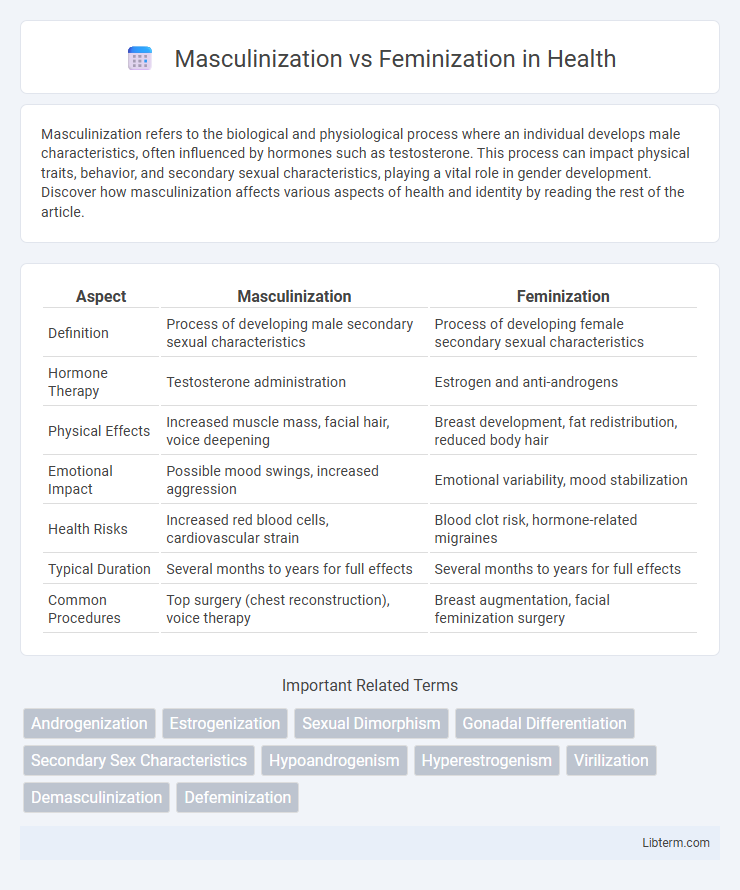Masculinization refers to the biological and physiological process where an individual develops male characteristics, often influenced by hormones such as testosterone. This process can impact physical traits, behavior, and secondary sexual characteristics, playing a vital role in gender development. Discover how masculinization affects various aspects of health and identity by reading the rest of the article.
Table of Comparison
| Aspect | Masculinization | Feminization |
|---|---|---|
| Definition | Process of developing male secondary sexual characteristics | Process of developing female secondary sexual characteristics |
| Hormone Therapy | Testosterone administration | Estrogen and anti-androgens |
| Physical Effects | Increased muscle mass, facial hair, voice deepening | Breast development, fat redistribution, reduced body hair |
| Emotional Impact | Possible mood swings, increased aggression | Emotional variability, mood stabilization |
| Health Risks | Increased red blood cells, cardiovascular strain | Blood clot risk, hormone-related migraines |
| Typical Duration | Several months to years for full effects | Several months to years for full effects |
| Common Procedures | Top surgery (chest reconstruction), voice therapy | Breast augmentation, facial feminization surgery |
Understanding Masculinization and Feminization
Masculinization refers to the process by which biological, physiological, or behavioral traits typically associated with male characteristics develop, often influenced by hormones like testosterone. Feminization involves the development of traits traditionally linked to female biology and behavior, frequently associated with the action of estrogen and other female sex hormones. Understanding masculinization and feminization is crucial in fields such as endocrinology, gender studies, and medical treatments related to hormone therapy and sexual development disorders.
Key Biological Differences
Masculinization involves the development of male secondary sexual characteristics primarily driven by androgens like testosterone, influencing traits such as increased muscle mass, body hair, and a deeper voice. Feminization is characterized by the influence of estrogens and progesterone, promoting features such as breast development, wider hips, and a higher percentage of body fat in specific areas. Key biological differences stem from chromosomal variations (XY in males, XX in females), hormonal profiles, and the presence or absence of specific receptors and enzymes affecting tissue differentiation and function.
Hormonal Influences and Effects
Hormonal influences play a critical role in the process of masculinization and feminization, primarily driven by androgens such as testosterone and estrogens like estradiol. Testosterone promotes the development of male secondary sexual characteristics, including increased muscle mass, body hair, and deepening of the voice, while estrogen facilitates female traits such as breast development, fat distribution in hips and thighs, and regulation of the menstrual cycle. The balance and timing of these hormones during prenatal development and puberty significantly impact the physical and neurological differentiation between male and female phenotypes.
Psychological Dimensions
Masculinization and feminization in psychological dimensions encompass distinct patterns of gender identity, cognitive styles, and emotional processing influenced by biological, social, and environmental factors. Research indicates that masculinization often correlates with traits like assertiveness, spatial reasoning, and reduced emotional expressivity, whereas feminization is associated with empathy, verbal fluency, and heightened emotional awareness. Understanding these psychological variations aids in comprehending gender identity development, mental health outcomes, and tailored therapeutic approaches.
Social Constructs and Gender Norms
Masculinization and feminization represent social constructs rooted in gender norms that dictate behavior, roles, and expectations for individuals based on perceived sex. These processes reinforce societal stereotypes, often promoting traits like aggression or emotional restraint for masculinization and nurturing or passivity for feminization. Challenging these constructs reveals the fluidity of gender identity and highlights the impact of cultural context on shaping gendered behavior.
Cultural Interpretations Across Societies
Masculinization and feminization are often interpreted through distinct cultural lenses, shaping societal roles, behaviors, and expectations worldwide. In many patriarchal societies, masculinization is linked with strength, authority, and leadership, while feminization is associated with nurturing, empathy, and domestic responsibilities. Some cultures challenge these binaries by embracing fluid gender expressions, demonstrating how cultural context critically frames the meaning and value of masculinized and feminized traits.
Health Implications and Outcomes
Masculinization and feminization treatments involve hormone therapy that significantly impact cardiovascular health, bone density, and mental well-being. Testosterone therapy in masculinization can increase red blood cell count and risk of cardiovascular issues, while estrogen in feminization heightens the risk of thromboembolism and changes fat distribution. Careful monitoring of hormone levels and metabolic parameters is crucial to optimizing long-term health outcomes and minimizing adverse effects in transgender individuals undergoing these treatments.
Masculinization and Feminization in Medicine
Masculinization in medicine involves the development or enhancement of male characteristics through hormone therapy, often utilized in transgender men or patients with hypogonadism, typically employing testosterone to induce traits such as increased muscle mass, voice deepening, and facial hair growth. Feminization refers to the medical use of estrogen and anti-androgens to promote female secondary sexual characteristics in transgender women or individuals with androgen excess disorders, facilitating breast development, redistribution of body fat, and reduction of male-pattern hair growth. Both processes require careful medical supervision to balance hormone levels and monitor potential side effects for optimal patient outcomes.
Impacts on Identity and Expression
Masculinization and feminization procedures significantly influence individual identity and gender expression by aligning physical characteristics with one's gender identity, enhancing psychological well-being and social congruence. Hormone therapies and surgical interventions reshape secondary sexual traits, such as voice pitch, body hair, and facial structure, facilitating authentic self-presentation and reducing gender dysphoria. These changes contribute to improved self-esteem, social acceptance, and overall quality of life for transgender and non-binary individuals navigating their gender journey.
Future Perspectives and Ongoing Research
Future perspectives in masculinization and feminization focus on personalized hormone therapies tailored to genetic and epigenetic profiles, improving efficacy and minimizing side effects. Ongoing research explores advanced techniques like selective receptor modulators and gene editing to enhance tissue-specific outcomes and long-term safety. Novel biomarker identification and AI-driven treatment algorithms aim to optimize gender-affirming care and expand accessibility globally.
Masculinization Infographic

 libterm.com
libterm.com